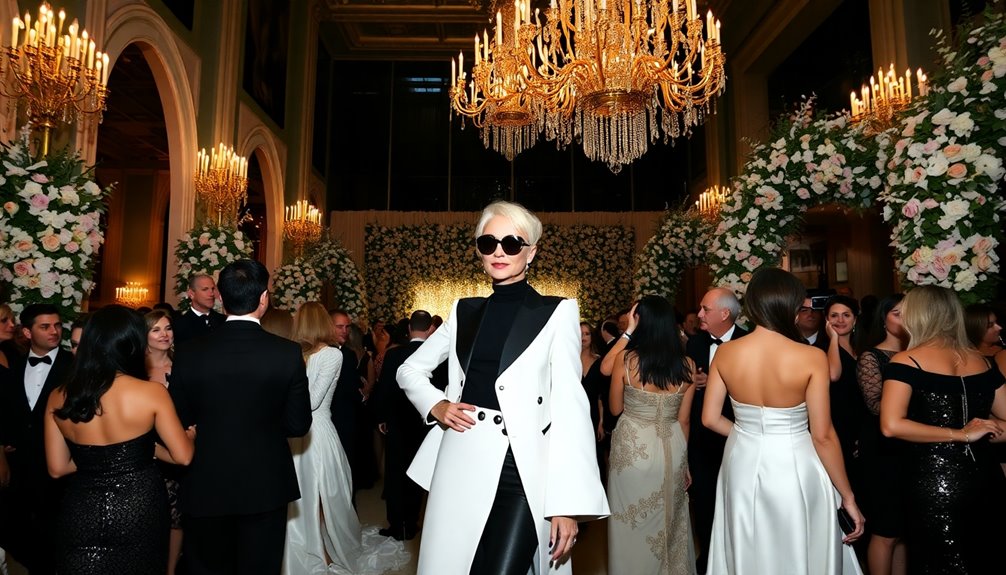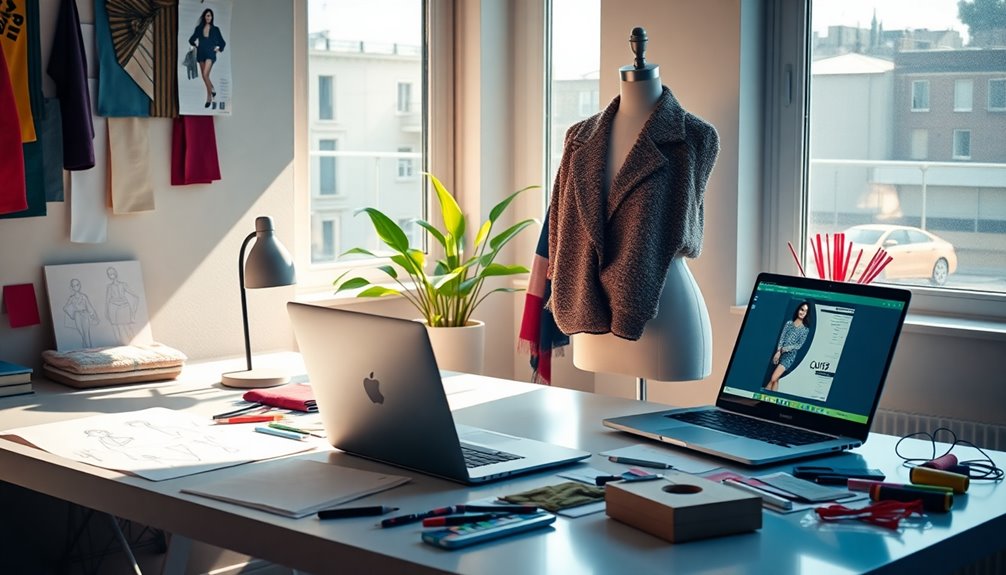Fashion design's journey from pioneers like Charles Frederick Worth and Coco Chanel to today's global giants highlights an exciting evolution. You've got the rise of haute couture, innovative fashion shows, and new looks redefining styles. Technological advancements, like CAD and 3D printing, have transformed garment production, while sustainability has become a focus for eco-conscious consumers. The industry's growth reflects a shift toward digital engagement and understanding consumer preferences. As you explore how this dynamic field adapts to challenges and embraces future trends, you'll uncover the intricate layers shaping fashion today.
Key Takeaways
- Charles Frederick Worth laid the foundation for haute couture, transforming fashion presentation through live models and fashion shows.
- Coco Chanel revolutionized women's fashion by introducing casual elegance and making haute couture more accessible.
- Christian Dior's "New Look" emphasized femininity in fashion, reshaping silhouettes and styles post-World War II.
- Technological advancements like CAD, 3D printing, and data analytics have reshaped the design and production processes in the fashion industry.
- The shift towards sustainability and social responsibility is becoming essential, as consumers increasingly demand eco-friendly and ethically produced fashion products.
Historical Evolution of Fashion

Fashion design has come a long way since its early days, evolving considerably from the 19th century onward.
You'll find that Charles Frederick Worth, recognized as the first fashion designer, revolutionized the industry by founding haute couture. His innovative approach shifted the focus from individual dressmakers to established fashion houses, setting the stage for a new luxury era. Worth introduced live models and fashion shows, enchanting aristocratic audiences and transforming how designs were presented.
As you explore this evolution, you'll note how iconic designers like Coco Chanel and Christian Dior further shaped haute couture, making it more glamorous and accessible.
This historical context lays the groundwork for understanding today's vibrant and diverse fashion landscape.
Pioneers of Fashion Design
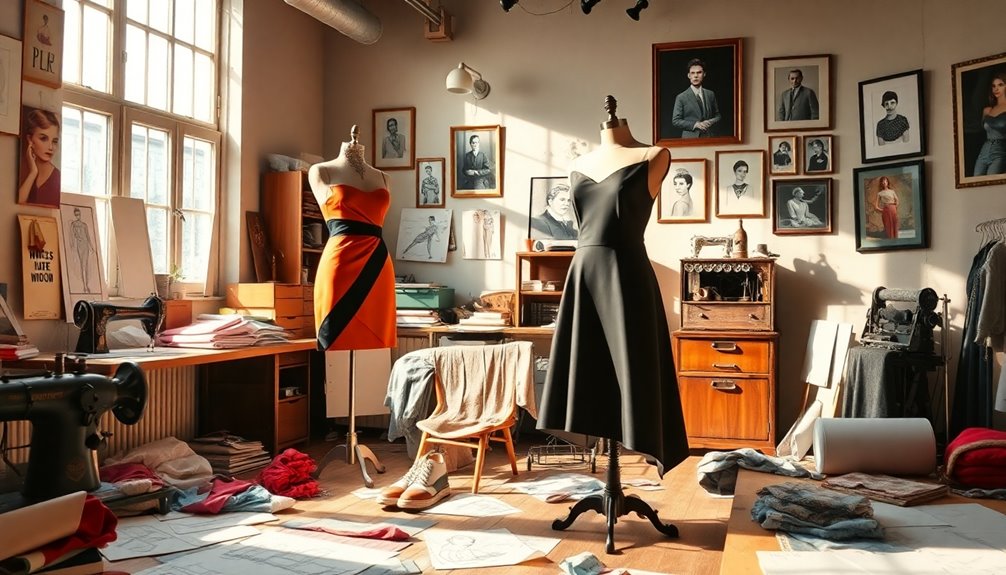
The evolution of fashion design owes much to its pioneers, who laid the foundation for the industry as it is understood today. Designers like Charles Frederick Worth, Coco Chanel, and Christian Dior transformed how fashion was created and presented. They introduced innovative techniques that changed the landscape forever.
| Designer | Contribution |
|---|---|
| Charles Frederick Worth | Founded haute couture |
| Coco Chanel | Popularized casual elegance |
| Christian Dior | Introduced the "New Look" |
| Yves Saint Laurent | Blurred gender lines in fashion |
| Valentino | Elevated glamour and romance |
These pioneers not only shaped the aesthetics of their time but also influenced future generations, creating a legacy that continues to inspire modern fashion designers today.
Technological Advancements in Fashion

In today's design landscape, technology's impact is reshaping how you create and produce garments.
You're likely utilizing CAD and CAM systems to enhance precision and efficiency, streamlining your design process.
3D printing allows for on-demand production, drastically reducing waste and costs while giving you the freedom to experiment.
Intelligent textiles and smart fabrics are integrating electronics into your designs, offering innovative functionalities that redefine wearables.
With advanced digital design software, you can quickly respond to emerging trends, enhancing your creative output.
New materials, including recycled fibers, are expanding your options, enabling you to push boundaries in innovation.
Embracing these technological advancements not only elevates your work but also positions you at the forefront of the evolving fashion industry.
Sustainability in Fashion Design
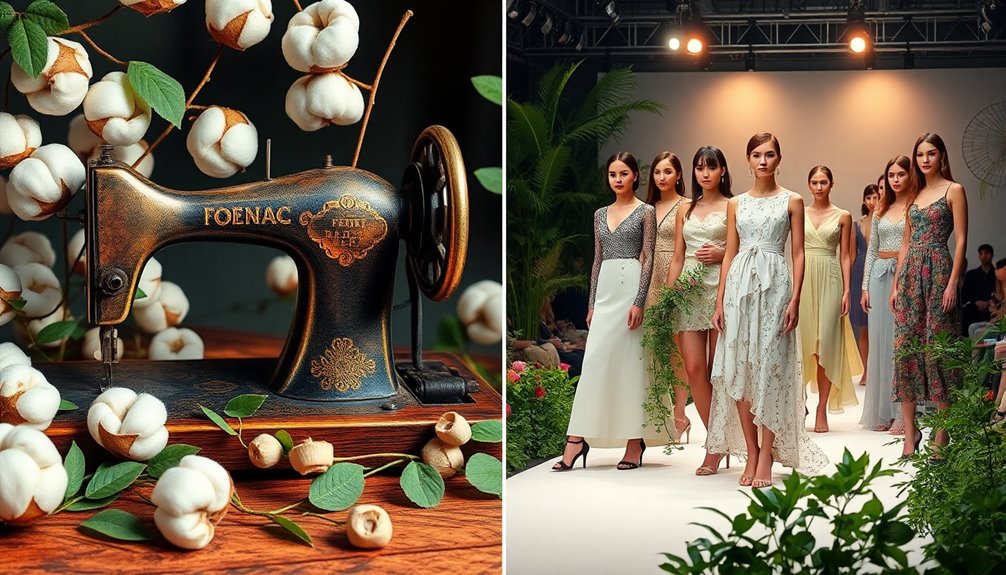
Sustainability is becoming a pivotal focus in fashion design, with 60% of consumers actively seeking eco-friendly products.
As a designer, you can make a significant impact by choosing sustainable materials and ethical production methods. Incorporating recycled fabrics, organic cotton, and biodegradable textiles not only addresses environmental concerns but also appeals to conscious consumers.
You might also consider adopting circular fashion principles, such as designing for longevity and encouraging recycling or upcycling of garments.
Collaborating with suppliers who prioritize fair labor practices enhances your brand's integrity. Furthermore, integrating sustainable fashion practices into your design process can further strengthen your brand's commitment to environmental responsibility.
Fashion's Social Responsibilities

Fashion designers today hold significant social responsibilities that extend beyond aesthetics. You're not just creating beautiful garments; you're setting trends that can impact social issues.
By advocating for sustainability, you promote responsible sourcing and fair labor practices, responding to the growing consumer demand for eco-friendly products. Embracing diversity in your designs helps foster representation and empowerment across various demographics, making fashion more inclusive.
Building trust with suppliers and customers is essential, enhancing brand loyalty and reinforcing ethical practices. Understanding market trends allows you to navigate consumer behavior effectively, ensuring your designs resonate.
Ultimately, your role isn't just about fashion; it's about influencing positive change within the industry and society at large. Additionally, by prioritizing eco-friendly practices in your designs, you contribute to reducing the overall environmental impact of the fashion industry.
Industry Growth and Challenges
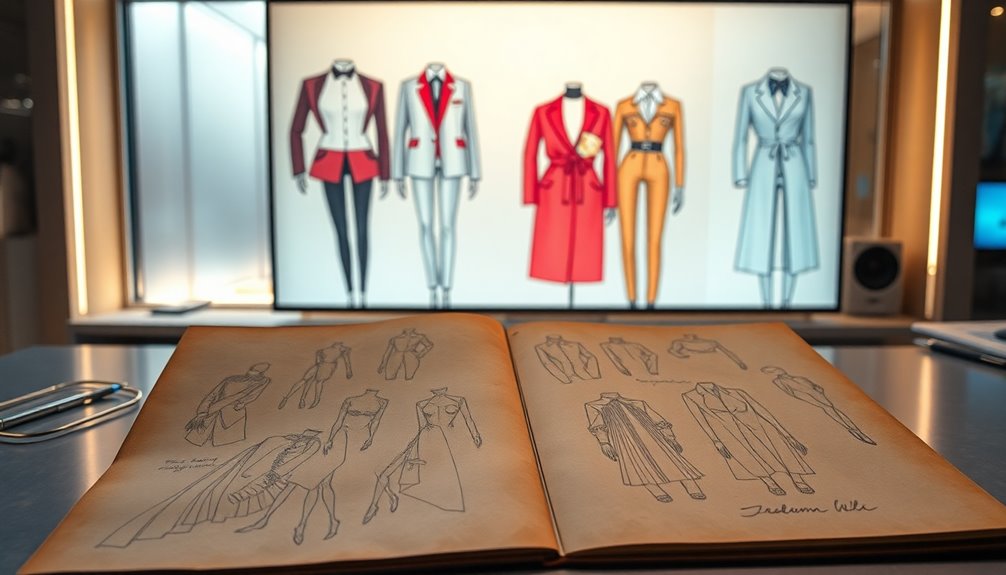
There's no denying that the fashion industry faces both growth opportunities and significant challenges.
As you look at the projections, the US market is set to grow by 2.1% to $358.7 billion by 2024, while the global apparel market may reach nearly $1.8 trillion.
However, the pandemic highlighted vulnerabilities, causing an 11.46% revenue decline in 2020.
E-commerce's rise, now accounting for 29% of sales, reshapes how consumers shop.
You'll also see pressure for sustainability, with many consumers demanding eco-friendly options.
Balancing innovation with ethical practices is essential.
While the industry evolves, adapting to these growth prospects while addressing challenges will be key to thriving in this dynamic landscape.
Future Trends in Fashion
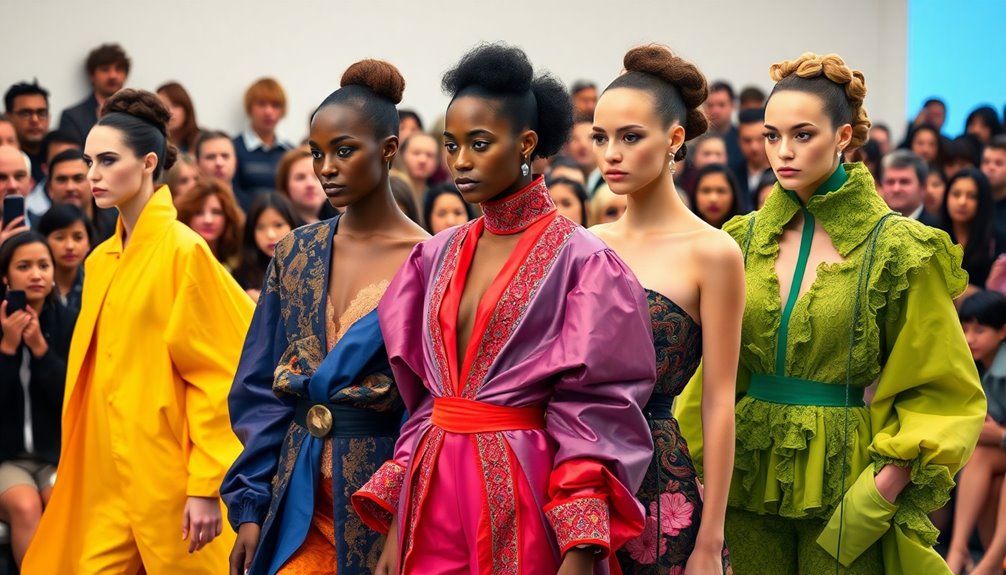
As the fashion industry grapples with growth opportunities and challenges, you'll notice a clear shift toward innovative practices that prioritize sustainability and inclusivity.
Regenerative materials are becoming essential, as brands seek to reduce their environmental impact. Rental and subscription models are gaining traction, allowing you to access high-quality fashion without the commitment of ownership, reflecting trends seen in the aquatic adventures sector where shared experiences are valued. Holistic SEO strategies can also benefit fashion brands by enhancing their online visibility and engagement.
You'll see an increased emphasis on eco-friendly production methods, reflecting consumer demand for responsible choices. Furthermore, integrating solar energy technologies into production can significantly reduce carbon footprints. Inclusivity in design will be pivotal, with diverse influences shaping collections that resonate with a broader audience.
Additionally, advancements in technology will streamline production processes, enabling faster responses to trends. This evolution will also incorporate renewable energy technologies, further enhancing the industry's commitment to sustainability.
This evolution won't only redefine fashion but also create a more responsible and engaging industry for everyone involved.
The Role of Designers Today

Today, designers play an essential role as creative visionaries and brand ambassadors, shaping the identity of their labels in a rapidly evolving marketplace. Their impact is profound, and it revolves around three key areas:
- Innovation: Designers embrace new technologies, like 3D printing and smart textiles, to create sustainable and functional fashion. This includes utilizing AI technologies to enhance design processes and improve efficiency, which aligns with the principles of design thinking to drive innovative solutions. Furthermore, AI-powered data analytics can provide insights into consumer preferences, enabling designers to tailor their creations more effectively. Additionally, the use of imagination in the design process can unlock transformative possibilities, leading to groundbreaking fashion concepts.
- Advocacy: They champion social responsibility, promoting sustainability, inclusivity, and fair labor practices, responding to consumer demand for ethical options.
- Engagement: By leveraging social media and digital platforms, designers connect directly with consumers, making their brand more accessible and relatable.
In this dynamic environment, you'll find designers not only creating but also influencing and shaping the future of fashion. This includes the importance of maintaining high vibrational energy in their creative processes, which can enhance their overall impact and success.
Their multifaceted role is vital in maneuvering today's challenges and opportunities.
Frequently Asked Questions
How Do Fashion Designers Choose Their Inspirations for Collections?
When you're choosing inspirations for your fashion collections, you tap into various sources like art, nature, and cultural trends.
You might explore historical references or personal experiences, allowing your unique perspective to shine.
Collaborating with other creatives can spark fresh ideas, while observing current events keeps your designs relevant.
Ultimately, blending these influences helps you create a collection that resonates with your audience and reflects your distinct style and vision.
What Skills Are Essential for a Successful Fashion Designer?
Imagine a painter standing before a blank canvas, brush poised, ready to create.
As a fashion designer, you need a palette of essential skills. Creativity fuels your designs, while technical expertise helps you bring those ideas to life. Strong communication aids collaboration, and business acumen guarantees your brand thrives.
Adaptability lets you respond to trends, and a keen eye for detail elevates your work, transforming visions into wearable art that captivates the world.
How Do Fashion Trends Emerge and Spread Globally?
Fashion trends emerge from a mix of cultural influences, social movements, and technological advancements.
You'll notice that designers often draw inspiration from street style, art, and popular culture.
Social media plays a vital role in spreading these trends quickly, allowing influencers and celebrities to showcase new styles.
As you engage with these platforms, you'll see how trends gain momentum, reaching a global audience and shaping what becomes fashionable in various markets.
What Are the Key Differences Between Haute Couture and Ready-To-Wear?
Imagine a luxurious gown, meticulously crafted by hand, each stitch a demonstration of artistry—that's haute couture.
In contrast, picture a stylish dress, mass-produced in vibrant colors, ready to be shipped to stores worldwide—that's ready-to-wear.
Haute couture's exclusive, custom-fitted garments cater to a select clientele, while ready-to-wear focuses on accessibility and practicality.
Both play essential roles in fashion, yet they embody different philosophies of design and consumer experience.
How Can Aspiring Designers Break Into the Fashion Industry?
To break into the fashion industry, you should start by building a strong portfolio showcasing your unique designs.
Networking is key, so attend industry events and connect with professionals.
Consider internships or entry-level positions to gain valuable experience.
Stay updated on trends and technologies by following fashion news and taking relevant courses.
Finally, leverage social media to showcase your work and engage with potential clients or employers, making your presence known in the industry.
Conclusion
As you can see, the world of fashion design is a vibrant tapestry woven from creativity, innovation, and responsibility. From the trailblazing pioneers to today's global giants, each thread tells a story of evolution. As the industry faces new challenges, embracing sustainability and inclusivity is essential. So, keep your finger on the pulse of fashion; it's an ever-changing landscape where new ideas and trends are always just around the corner, ready to reshape the future.



